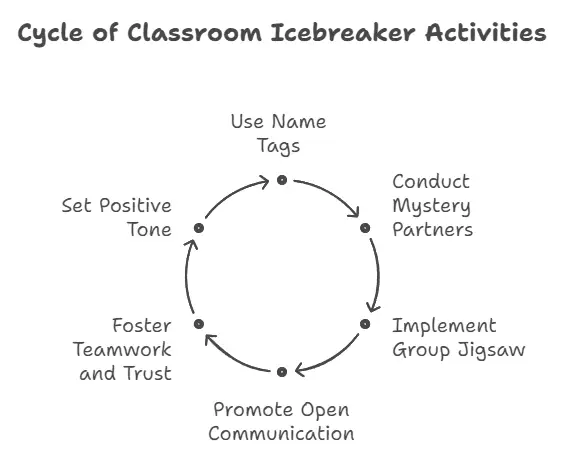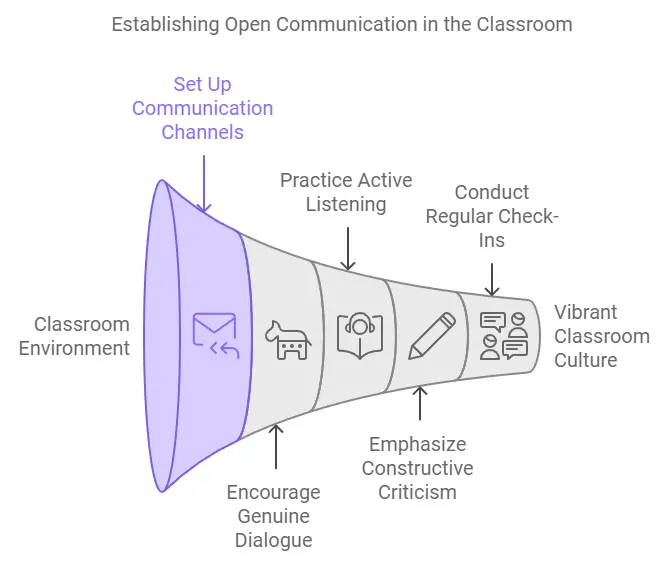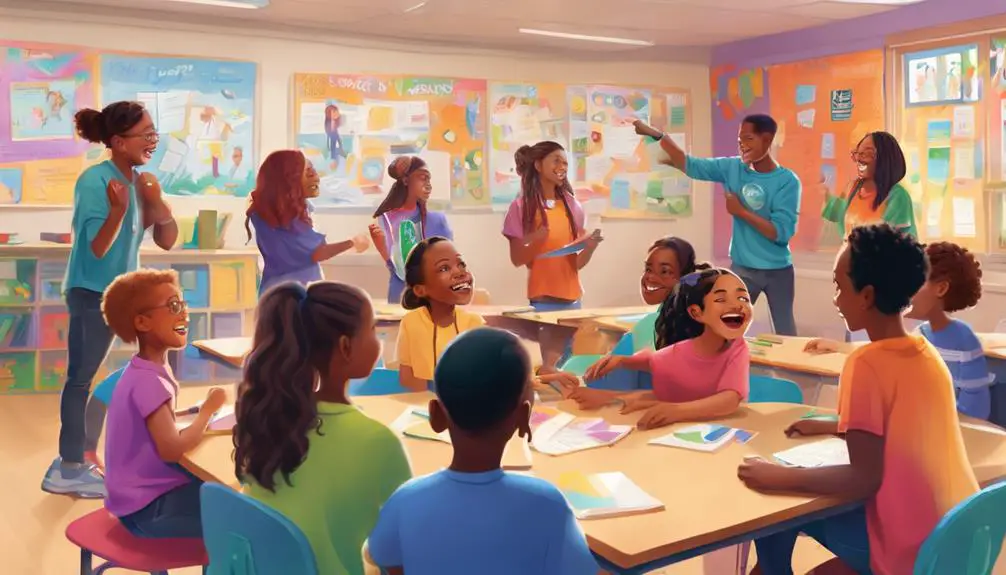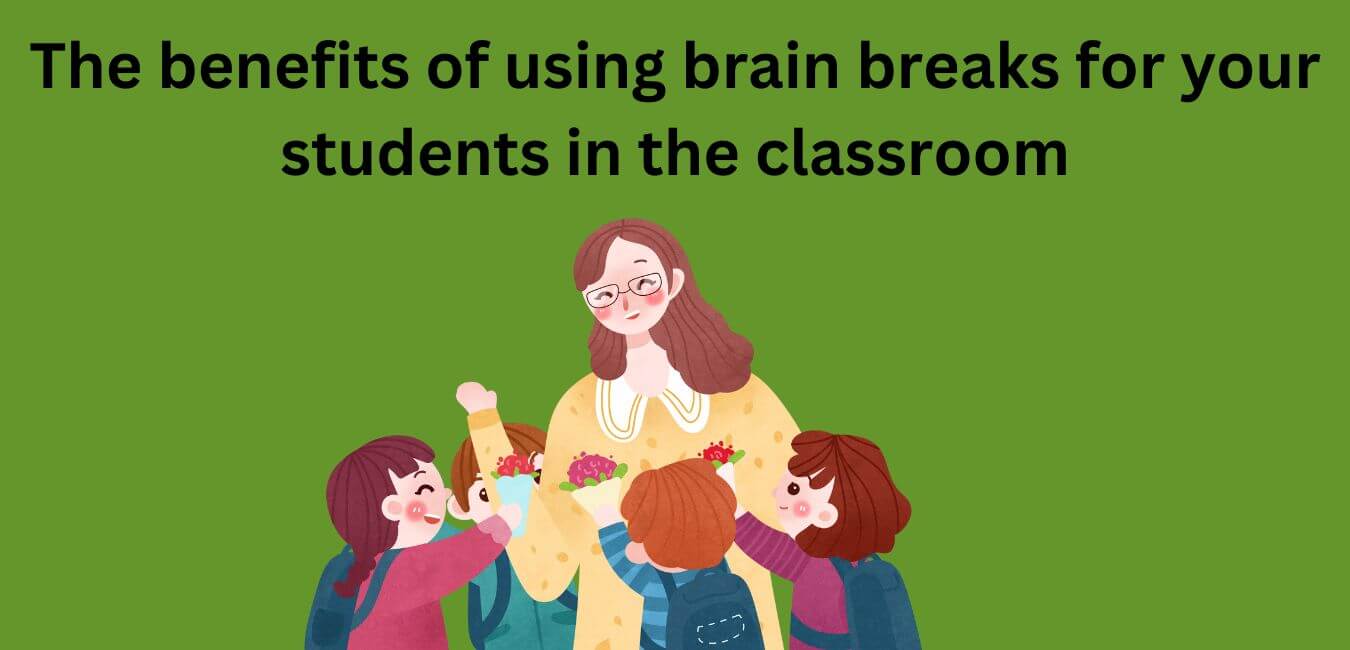I’m consistently struck by the essential role camaraderie plays in the classroom, and I’ve discovered that implementing strategic approaches can yield significant benefits.
Whether through engaging icebreaker activities or collaborative projects, establishing an environment where students feel connected and supported is crucial.
I’ve witnessed firsthand how these methods build trust and encourage open communication, yet I’m curious about the potential deeper impacts on student relationships.
What other strategies could we explore to enhance this sense of belonging?
Strategies for Fostering Classroom Camaraderie
There are several approaches to consider when fostering camaraderie in the classroom.
To start off, engaging in icebreaker activities and collaborative group projects can be effective in helping students build connections with one another.
Peer mentoring programs are another valuable resource for promoting support and understanding among students.
Assigning classroom roles and incorporating team-building exercises can also play a significant role in creating a sense of belonging within the class.
Cultivating a strong community in the classroom not only enhances academic success but also cultivates a nurturing environment for students to thrive and develop.
Icebreaker Activities
Icebreaker activities play a crucial role in building connections within the classroom. They help create a friendly and inclusive atmosphere where everyone feels valued and appreciated. One fun idea is using Name Tags with interesting facts about each student, making it easier to remember names and sparking conversations.
Another engaging activity is Mystery Partners, where students team up based on shared interests from Icebreaker Questions. This fosters bonding and helps students discover common ground.
The Group Jigsaw method is also effective, as it encourages teamwork and trust-building through collaborative projects or puzzles.
Integrating these activities at the beginning of the school year or during transitions breaks down barriers and promotes open communication. These strategies have proven to quickly break down walls and cultivate genuine friendships.
Ultimately, icebreaker activities set a positive tone, creating an inclusive environment where everyone feels empowered to engage and contribute to the classroom community. Let’s continue to explore new ways to strengthen our classroom bond!

Collaborative Group Projects
Collaborative group projects offer a unique opportunity to enhance camaraderie among students. When facilitating these projects, I observe students not only mastering the subject matter but also honing essential skills that promote teamwork and friendship.
Emphasizing group dynamics helps create an inclusive environment where every individual contributes meaningfully and feels appreciated.
Here are some strategies I employ to enhance collaboration:
- Role Assignment: Allocating specific roles ensures that each student has a defined responsibility, fostering accountability and active participation.
- Creative Collaboration: Encouraging brainstorming sessions enables students to freely exchange ideas, making the project more engaging and innovative.
- Project Management: Teaching fundamental project management skills, such as planning and time management, equips students to work efficiently as a cohesive team.
- Peer Feedback: Integrating structured peer feedback sessions allows students to learn from each other and gain a deeper appreciation for diverse perspectives.
Ultimately, these joint efforts not only result in successful projects but also cultivate enduring relationships among students. As they support one another, camaraderie thrives, creating a more positive and unified classroom atmosphere.
Peer Mentoring Programs
In any classroom setting, peer mentoring programs can play a pivotal role in enhancing student relationships. Witnessing firsthand the positive impact of these initiatives, I’ve seen how they create a supportive environment conducive to mentorship. Pairing students with varying skill levels fosters dynamic relationships that facilitate growth for both mentors and mentees.
Through skill sharing, students not only enhance their own abilities but also cultivate a sense of unity within the group. Observing students stepping into the role of mentors, they inspire each other to strive for excellence. This model cultivates a positive atmosphere where all individuals feel valued and encouraged.
The essence of peer mentoring lies in the reciprocal support it nurtures. I’ve observed that when students can depend on each other, their confidence soars, and their willingness to assist one another increases. They learn to celebrate each other’s accomplishments and navigate challenges as a team.
Ultimately, peer mentoring programs promote a culture of collaboration and empathy, emphasizing that learning isn’t just about personal achievements but also about uplifting one another and fostering a vibrant classroom community. Embracing this approach can lead to lasting friendships and a more interconnected learning experience.
Classroom Roles Assignment
Assigning specific classroom roles can truly enhance the bond among students. When roles are assigned, I observe not only better teamwork but also individual growth. Rotating roles regularly allows students to appreciate different responsibilities and perspectives, leading to the development of leadership skills as each student gets a chance to lead and support their peers.
Here are some effective ways to assign classroom roles:
- Encourage sharing responsibilities: Each role brings specific tasks, fostering a sense of shared responsibility.
- Promote student empowerment: Assigning roles gives students a sense of ownership in their learning environment.
- Use engagement strategies: Roles like note-taker, timekeeper, or discussion leader keep everyone involved and engaged.
- Facilitate collaboration: Working together in various capacities strengthens relationships and builds trust.
Team-Building Exercises
Creating a strong sense of camaraderie in the classroom often begins with interactive team-building activities. Incorporating trust exercises can establish a safe and open environment among students, encouraging them to share their thoughts and feelings more freely.
Engaging in cooperative challenges is another excellent method to foster teamwork. By collaborating to solve problems, students enhance their social skills and learn the value of working together. Setting up activities that require them to rely on each other’s strengths helps to develop trust and mutual understanding.
Practicing empathy is also crucial. Empathy activities prompt students to consider different perspectives by putting themselves in their peers’ shoes.
Through simple role-playing scenarios, they gain insight into the emotions and experiences of others, strengthening their connections with one another.
Trust-Building Games
Trust plays a pivotal role in effective teamwork, and incorporating trust-building games can significantly enhance students’ relationships and collaboration skills. These activities not only help in fostering connections but also create a secure space for students to open up.
Here are some games that have proven to be impactful in my classroom:
- Trust Circles: Students form a circle, with one person standing in the middle. They take turns leaning back and falling into the arms of their peers, reinforcing trust and mutual support.
- Empathy Exercises: Partners share personal experiences while the other listens attentively, promoting understanding and empathy.
- Compliment Chains: Each student gives a compliment to the person next to them, cultivating a positive and uplifting environment that boosts self-esteem.
- Vulnerability Sharing: Students share their fears or challenges in small groups, allowing them to connect on a deeper level and build trust.
Integrating activities like team charades can also be beneficial as they require teamwork and effective communication.
Through prioritizing trust-building games, I’ve witnessed a remarkable transformation in classroom dynamics. Trust fosters a harmonious and productive learning environment, making it a valuable goal to pursue.
Open Communication Channels
Establishing an environment of open communication is crucial for nurturing camaraderie in the classroom. Encouraging genuine dialogue among students not only strengthens bonds but also fosters trust.
Setting up clear channels for honest feedback invites students to express their thoughts and feelings without fear of judgment, creating a supportive and inclusive atmosphere where everyone feels valued.
Active listening plays a pivotal role in this process. When I actively listen to my students, I demonstrate that their opinions are important. I encourage them to practice this skill with each other, enhancing the sense of community within our classroom.
Emphasizing the value of constructive criticism, I guide students to offer feedback that’s both supportive and growth-oriented, ensuring they understand how to help one another effectively.
Regular check-ins or discussion sessions help sustain this culture of open communication. As students become more comfortable sharing their thoughts, they’re more likely to collaborate and support one another.
Ultimately, cultivating an environment where open communication thrives not only enhances camaraderie but also contributes to a vibrant classroom culture where all individuals can flourish.

Celebrating Achievements Together
Imagine standing in front of a mirror, envisioning a classroom filled with open communication, setting the stage for a supportive environment where achievements are celebrated together.
Recognizing and honoring successes, regardless of size, cultivates a sense of belonging and motivation. Various strategies can be integrated to foster a team celebration atmosphere:
- Wall of Achievements: Create a designated area for students to showcase their accomplishments, witnessing their pride in sharing progress.
- Celebratory Traditions: Establish simple yet meaningful rituals, like a weekly shout-out session, providing a platform for all to share their achievements.
- Emphasis on Team Success: Highlight collective achievements, reinforcing the idea that individual contributions are valuable and that progress is a collective effort.
- Milestone Celebrations: Organize milestone parties to mark significant goals, enabling everyone to relax, bond, and reflect on the journey together.
These approaches help create a supportive and inclusive classroom environment where accomplishments are acknowledged and celebrated as a team.
Diverse Learning Styles
Understanding that students have different ways of learning is crucial for building a sense of unity in the classroom. Recognizing and accommodating each student’s unique learning preferences not only enhances their educational journey but also strengthens the bond within our class.
Employing flexible teaching techniques allows me to cater to a variety of learning styles, ensuring that everyone feels included and respected. Integrating visual aids is beneficial for visual learners, aiding in their comprehension of concepts, while auditory learners thrive in discussions and lectures.
I also embrace a multimodal approach to teaching, blending diverse methods to engage all students effectively. This inclusive method fosters collaboration, enabling students to share their perspectives and insights.
Creating an interactive and stimulating learning environment boosts student involvement and fosters connections among peers. Encouraging collaborative projects that showcase diverse strengths cultivates a supportive atmosphere within the classroom.
Prioritizing diverse learning styles not only promotes camaraderie but also cultivates a welcoming space where all students can flourish together.
Shared Responsibility Initiatives
Incorporating shared responsibility initiatives can enhance classroom camaraderie by valuing diverse learning styles. These initiatives promote a sense of belonging and teamwork among students.
Some effective strategies include assigning different roles in group projects to ensure everyone contributes and learns from each other, implementing responsibility circles where students take turns leading discussions or activities to encourage leadership and accountability, involving students in decision-making processes like setting class rules or selecting project topics to foster ownership and investment in the classroom, and pairing students as accountability partners to support each other’s goals and progress.
These initiatives empower students to take ownership of their learning, leading to mutual respect and a stronger bond, ultimately creating a more cohesive and supportive classroom atmosphere.
Together, we can cultivate a space where everyone thrives!
Conflict Resolution Strategies
Conflicts are a common occurrence in any classroom, but addressing them effectively can significantly enhance the camaraderie among students.
Utilizing specific strategies for conflict resolution can help create a supportive environment. Here is a simple framework that I often use:
- Mediation Techniques: These techniques involve facilitating discussions where both parties can openly express their feelings and perspectives.
- Conflict Circles: By creating a safe space for students to share their viewpoints within a group setting, conflicts can be addressed in a constructive manner.
- Role Playing Scenarios: Allowing students to act out situations can help them better understand each other’s perspectives and promote empathy.
- Active Listening: Teaching students to listen without interrupting ensures that everyone feels heard and valued in the resolution process.
- Restorative Practices: Instead of assigning blame, focusing on repairing harm and restoring relationships is key to resolving conflicts positively.
Encouraging Positive Interactions
To foster a classroom environment where camaraderie thrives, I prioritize promoting positive interactions among students. Building a sense of connection is crucial, and I employ various strategies to cultivate this atmosphere.
Here are some effective techniques I utilize:
- Compliment Circles: Students are encouraged to express sincere compliments about their peers, fostering trust and appreciation within the group.
- Empathy Exercises: I organize activities that allow students to see things from each other’s perspectives, promoting understanding and kindness.
- Active Listening: Teaching students the value of attentive listening to each other ensures that everyone feels heard and valued.
- Gratitude Journals: Students are prompted to write down things they appreciate, including positive interactions with their classmates, reinforcing their connections.
Moreover, I introduce friendship challenges to prompt students to initiate relationships beyond their usual social circles.
Inclusive Classroom Environment
Creating an inclusive classroom environment is crucial for building a sense of camaraderie among students. Prioritizing cultural inclusivity ensures that every student feels valued and respected. Actively seeking diverse perspectives enriches our discussions and helps students appreciate each other’s backgrounds.
I ensure that all materials are accessible to everyone, regardless of their needs, fostering a sense of belonging among students. Emphasizing awareness of neurodiversity celebrates the unique ways of thinking and learning present in the classroom.
Supporting language diversity is also key. I encourage students to share their languages and dialects, promoting pride in their identities.
This practice not only enhances communication but also forges connections between students, leading to lasting friendships.
Community Service Opportunities
To enhance the sense of community within our classroom, engaging students in community service activities can significantly strengthen their relationships. Participating in service learning not only benefits the community but also nurtures a feeling of social responsibility.
Partnering with local charities can create meaningful experiences for all involved. Here are some ideas to consider:
- Plan group volunteering days at nearby charities to foster teamwork and a shared sense of purpose.
- Establish partnerships with organizations that align with our classroom values, ensuring continued involvement and impact.
- Host fundraising events where students can showcase their talents, such as art or music, to support local causes.
- After each service project, encourage reflection activities to allow students to share their insights and experiences.
These volunteer opportunities not only enhance camaraderie among students but also cultivate a sense of belonging and connection to the broader community.
Engaging in service activities enables us to create a classroom environment that values empathy, teamwork, and the fulfillment of giving back.
Regular Reflection Sessions
In our classroom, holding regular reflection sessions can significantly enhance the bond among students. Structured reflection prompts help everyone express their thoughts and feelings openly.
Through feedback sessions, we actively listen to each other’s perspectives, creating a safe space for sharing. These emotional check-ins deepen our connections as we discuss personal goals and challenges.
It’s inspiring to witness how sharing our experiences nurtures empathy and understanding. When a student shares a struggle, it often encourages others to open up, fostering a sense of community and reducing feelings of isolation.
These shared experiences build trust and unity within our classroom. I encourage students to jot down what they’ve learned about themselves and their peers, aiding personal growth and enriching our collective journey.
These reflection sessions serve as a valuable tool in creating a supportive environment where each student feels valued and heard. Investing time in reflection cultivates a sense of belonging that enhances our ability to support one another.
Conclusion
Creating a sense of camaraderie in the classroom plays a crucial role in establishing a positive learning environment. Research shows that students in tightly-knit classrooms are 20% more likely to actively participate in class discussions. This underscores the significance of our efforts in fostering connections among students. Through activities like icebreakers and collaborative projects, we not only strengthen relationships but also cultivate a feeling of inclusion. Together, we can transform our classrooms into supportive communities where everyone can thrive and grow.
















